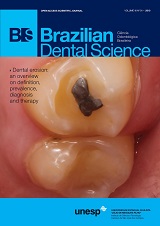Dental Erosion: an overview on definition, prevalence, diagnosis and therapy
DOI:
https://doi.org/10.14295/bds.2013.v16i1.868Abstract
Currently, it has been observed a significant increase in the prevalence of dental erosion as a consequence of frequent exposure to acids from foods, drinks and gastric juice. The aim of this review was to give some new insights about the definition and diagnosis of this condition, to clarify the causal factors and to show the preventive strategies and restorative therapy. Dental erosion is complex condition dependent on the interaction of chemical, biological and behavior factors. The diagnosis is generally performed by the analysis of the clinical appearance of the lesions in combination with the patient’s history. Some new technologies have been developed to help in early diagnosis and to quantify dental erosion in different phases. Preventive measures are established according to the causal factors, which may include the dietary intervention, modification of acidic drinks, and behavioral changes, or the modification of the tooth surface to increase its resistance against acidic attacks. The restorative treatment may range from minimally invasive therapies to multidisciplinary interventions. The clinicians should know how to detect the condition early, so that preventive measures can be applied before the lesions progress. Therapeutic strategies in high-risk patients should be as conservative as possible, involving multidisciplinary and preventive approaches with a periodic control for the success of the treatment.
Key-words: Epidemiology, Prevention, Rehabilitation, Treatment, Tooth erosion
Downloads
Downloads
Published
How to Cite
Issue
Section
License
Brazilian Dental Science uses the Creative Commons (CC-BY 4.0) license, thus preserving the integrity of articles in an open access environment. The journal allows the author to retain publishing rights without restrictions.
=================




























